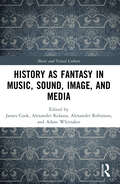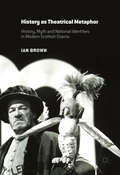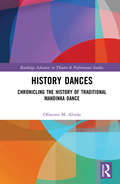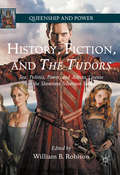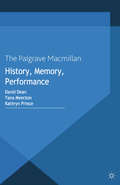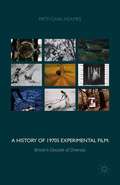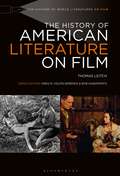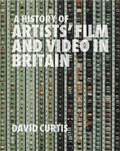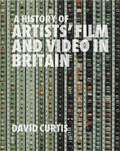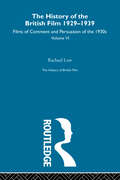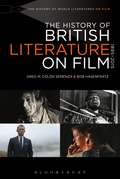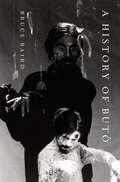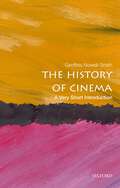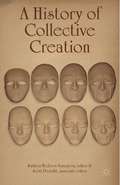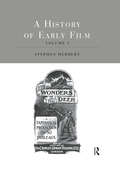- Table View
- List View
History as Fantasy in Music, Sound, Image, and Media (Music and Visual Culture)
by James Cook, Alexander Kolassa, Alexander Robinson, and Adam WhittakerExploring how music is used to portray the past in a variety of media, this book probes the relationship between history and fantasy in the imagination of the musical past. The volume brings together essays from multidisciplinary perspectives, addressing the use of music to convey a sense of the past in a wide range of multimedia contexts, including television, documentaries, opera, musical theatre, contemporary and historical film, videogames, and virtual reality. With a focus on early music and medievalism, the contributors theorise the role of music and sound in constructing ideas of the past. In three interrelated sections, the chapters problematise notions of historical authenticity on the stage and screen; theorise the future of musical histories in immersive and virtual media; and explore sound’s role in more fantastical appropriations of history in television and videogames. Together, they poseprovocative questions regarding our perceptions of ‘early’ music and the sensory experience of distant history. Offering new ways to understand the past at the crossroads of musical and visual culture, this collection is relevant to researchers across music, media, and historical and cultural studies.
History as Theatrical Metaphor: History, Myth and National Identities in Modern Scottish Drama
by Ian BrownThis revelatory study explores how Scottish history plays, especially since the 1930s, raise issues of ideology, national identity, historiography, mythology, gender and especially Scottish language. Covering topics up to the end of World War Two, the book addresses the work of many key figures from the last century of Scottish theatre, including Robert McLellan and his contemporaries, and also Hector MacMillan, Stewart Conn, John McGrath, Donald Campbell, Bill Bryden, Sue Glover, Liz Lochhead, Jo Clifford, Peter Arnott, David Greig, Rona Munro and others often neglected or misunderstood. Setting these writers’ achievements in the context of their Scottish and European predecessors, Ian Brown offers fresh insights into key aspects of Scottish theatre. As such, this represents the first study to offer an overarching view of historical representation on Scottish stages, exploring the nature of ‘history’ and ‘myth’ and relating these afresh to how dramatists use – and subvert – them. Engaging and accessible, this innovative book will attract scholars and students interested in history, ideology, mythology, theatre politics and explorations of national and gender identity.
History Dances: Chronicling the History of Traditional Mandinka Dance (Routledge Advances in Theatre & Performance Studies)
by Ofosuwa M. AbiolaThe field of history is founded on the interrogation of written documents from the past. However, culture is the center of life in Africa. As a result, in the past – and to a degree in the present – the process for documenting events in Africa was not written, it was performed. History Dances: Chronicling the History of Traditional Mandinka Dance argues that a wealth of information is housed within traditional Mandinka dance and, consequently, the dances can be used as an African-derived primary source for writing African history. Ofosuwa M. Abiola highlights the overall value of studying Mandinka dance history specifically, and African dance history generally, as well as addressing the issue of scarcity with regard to primary sources for writing African history. History Dances proves to be a vital read for both undergraduate students and scholars in the fields of dance history, African history, performance studies, and cultural anthropology.
History Dances: Chronicling the History of Traditional Mandinka Dance (Routledge Advances in Theatre & Performance Studies)
by Ofosuwa M. AbiolaThe field of history is founded on the interrogation of written documents from the past. However, culture is the center of life in Africa. As a result, in the past – and to a degree in the present – the process for documenting events in Africa was not written, it was performed. History Dances: Chronicling the History of Traditional Mandinka Dance argues that a wealth of information is housed within traditional Mandinka dance and, consequently, the dances can be used as an African-derived primary source for writing African history. Ofosuwa M. Abiola highlights the overall value of studying Mandinka dance history specifically, and African dance history generally, as well as addressing the issue of scarcity with regard to primary sources for writing African history. History Dances proves to be a vital read for both undergraduate students and scholars in the fields of dance history, African history, performance studies, and cultural anthropology.
History, Fiction, and The Tudors: Sex, Politics, Power, and Artistic License in the Showtime Television Series (Queenship and Power)
by William B. RobisonThis is the first book-length study of the award-winning historical drama The Tudors. In this volume twenty distinguished scholars separate documented history, plausible invention, and outright fantasy in a lively series of scholarly, but accessible and engaging essays. The contributors explore topics including Henry VIII, Catherine of Aragon, Anne Boleyn, his other wives and family, gender and sex, kingship, the court, religion, and entertainments.
History, Fiction, and The Tudors: Sex, Politics, Power, and Artistic License in the Showtime Television Series (Queenship and Power)
by William B. RobisonThis is the first book-length study of the award-winning historical drama The Tudors. In this volume twenty distinguished scholars separate documented history, plausible invention, and outright fantasy in a lively series of scholarly, but accessible and engaging essays. The contributors explore topics including Henry VIII, Catherine of Aragon, Anne Boleyn, his other wives and family, gender and sex, kingship, the court, religion, and entertainments.
History, Memory, Performance (Studies in International Performance)
by Kathryn Prince David Dean Yana MeerzonHistory, Memory, Performance is an interdisciplinary collection of essays exploring performances of the past in a wide range of trans-national and historical contexts. At its core are contributions from theatre scholars and public historians discussing how historical meaning is shaped through performance.
A History of 1970s Experimental Film: Britain's Decade of Diversity
by P. Gaal-HolmesThis comprehensive historical account demonstrates the rich diversity in 1970s British experimental filmmaking, acting as a form of reclamation for films and filmmakers marginalized within established histories. An indispensable book for practitioners, historians and critics alike, it provides new interpretations of this rich and diverse history.
The History of American Literature on Film (The History of World Literatures on Film)
by Thomas LeitchFrom William Dickson's Rip Van Winkle films (1896) to Baz Luhrmann's big-budget production of The Great Gatsby (2013) and beyond, cinematic adaptations of American literature participate in a rich and fascinating history. Unlike previous studies of American literature and film, which emphasize particular authors like Edith Wharton and Nathaniel Hawthorne, particular texts like Moby-Dick, particular literary periods like the American Renaissance, or particular genres like the novel, this volume considers the multiple functions of filmed American literature as a cinematic genre in its own right-one that reflects the specific political and aesthetic priorities of different national and historical cinemas even as it plays a decisive role in defining American literature for a global audience.
The History of American Literature on Film (The History of World Literatures on Film)
by Thomas LeitchFrom William Dickson's Rip Van Winkle films (1896) to Baz Luhrmann's big-budget production of The Great Gatsby (2013) and beyond, cinematic adaptations of American literature participate in a rich and fascinating history. Unlike previous studies of American literature and film, which emphasize particular authors like Edith Wharton and Nathaniel Hawthorne, particular texts like Moby-Dick, particular literary periods like the American Renaissance, or particular genres like the novel, this volume considers the multiple functions of filmed American literature as a cinematic genre in its own right-one that reflects the specific political and aesthetic priorities of different national and historical cinemas even as it plays a decisive role in defining American literature for a global audience.
The History of American Literature on Film (The History of World Literatures on Film)
by Thomas LeitchFrom William Dickson's Rip Van Winkle films (1896) to Baz Luhrmann's big-budget production of The Great Gatsby (2013) and beyond, cinematic adaptations of American literature participate in a rich and fascinating history. Unlike previous studies of American literature and film, which emphasize particular authors like Edith Wharton and Nathaniel Hawthorne, particular texts like Moby-Dick, particular literary periods like the American Renaissance, or particular genres like the novel, this volume considers the multiple functions of filmed American literature as a cinematic genre in its own right-one that reflects the specific political and aesthetic priorities of different national and historical cinemas even as it plays a decisive role in defining American literature for a global audience.
The History of American Literature on Film (The History of World Literatures on Film)
by Thomas LeitchFrom William Dickson's Rip Van Winkle films (1896) to Baz Luhrmann's big-budget production of The Great Gatsby (2013) and beyond, cinematic adaptations of American literature participate in a rich and fascinating history. Unlike previous studies of American literature and film, which emphasize particular authors like Edith Wharton and Nathaniel Hawthorne, particular texts like Moby-Dick, particular literary periods like the American Renaissance, or particular genres like the novel, this volume considers the multiple functions of filmed American literature as a cinematic genre in its own right-one that reflects the specific political and aesthetic priorities of different national and historical cinemas even as it plays a decisive role in defining American literature for a global audience.
A History of Artists' Film and Video in Britain
by David CurtisIn recent years the use of film and video by British artists has come to widespread public attention. Jeremy Deller, Douglas Gordon, Steve McQueen and Gillian Wearing all won the Turner Prize (in 2004, 1996, 1999 and 1997 respectively) for work made on video. This fin-de-siecle explosion of activity represents the culmination of a long history of work by less well-known artists and experimental film-makers. Ever since the invention of film in the 1890s, artists have been attracted to the possibilities of working with moving images, whether in pursuit of visual poetry, the exploration of the art form's technical challenges, the hope of political impact, or the desire to re-invigorate such time-honoured subjects as portraiture and landscape. Their work represents an alternative history to that of commercial cinema in Britain - a tradition that has been only intermittently written about until now. This major new book is the first comprehensive history of artists' film and video in Britain. Structured in two parts ('Institutions' and 'Artists and Movements'), it considers the work of some 300 artists, including Kenneth Macpherson, Basil Wright, Len Lye, Humphrey Jennings, Margaret Tait, Jeff Keen, Carolee Schneemann, Yoko Ono, Malcolm Le Grice, Peter Gidal, William Raban, Chris Welsby, David Hall, Tamara Krikorian, Sally Potter, Guy Sherwin, Lis Rhodes, Derek Jarman, David Larcher, Steve Dwoskin, James Scott, Peter Wollen and Laura Mulvey, Peter Greenaway, Patrick Keiller, John Smith, Andrew Stones, Jaki Irvine, Tracy Emin, Dryden Goodwin, and Stephanie Smith and Ed Stewart. Written by the leading authority in the field, A History of Artists' Film and Video in Britain, 1897-2004 brings to light the range and diversity of British artists' work in these mediums as well as the artist-run organisations that have supported the art-form's development. In so doing it greatly enlarges the scope of any understanding of 'British cinema' and demonstrates the crucial importance of the moving image to British art history.
A History of Artists' Film and Video in Britain
by David CurtisIn recent years the use of film and video by British artists has come to widespread public attention. Jeremy Deller, Douglas Gordon, Steve McQueen and Gillian Wearing all won the Turner Prize (in 2004, 1996, 1999 and 1997 respectively) for work made on video. This fin-de-siecle explosion of activity represents the culmination of a long history of work by less well-known artists and experimental film-makers. Ever since the invention of film in the 1890s, artists have been attracted to the possibilities of working with moving images, whether in pursuit of visual poetry, the exploration of the art form's technical challenges, the hope of political impact, or the desire to re-invigorate such time-honoured subjects as portraiture and landscape. Their work represents an alternative history to that of commercial cinema in Britain - a tradition that has been only intermittently written about until now. This major new book is the first comprehensive history of artists' film and video in Britain. Structured in two parts ('Institutions' and 'Artists and Movements'), it considers the work of some 300 artists, including Kenneth Macpherson, Basil Wright, Len Lye, Humphrey Jennings, Margaret Tait, Jeff Keen, Carolee Schneemann, Yoko Ono, Malcolm Le Grice, Peter Gidal, William Raban, Chris Welsby, David Hall, Tamara Krikorian, Sally Potter, Guy Sherwin, Lis Rhodes, Derek Jarman, David Larcher, Steve Dwoskin, James Scott, Peter Wollen and Laura Mulvey, Peter Greenaway, Patrick Keiller, John Smith, Andrew Stones, Jaki Irvine, Tracy Emin, Dryden Goodwin, and Stephanie Smith and Ed Stewart. Written by the leading authority in the field, A History of Artists' Film and Video in Britain, 1897-2004 brings to light the range and diversity of British artists' work in these mediums as well as the artist-run organisations that have supported the art-form's development. In so doing it greatly enlarges the scope of any understanding of 'British cinema' and demonstrates the crucial importance of the moving image to British art history.
The History of British Film (Volume 6): The History of the British Film 1929 - 1939: Films of Comment and Persuasion of the 1930's
by Rachael LowThis set is one of the cornerstones of film scholarship, and one of the most important works on twentieth century British culture. Published between 1948 and 1985, the volumes document all aspects of film making in Britain from its origins in 1896 to 1939.Rachael Low pioneered the interpretation of films in their context, arguing that to understand films it was necessary to establish their context. Her seven volumes are an object lesson in meticulous research, lucid analysis and accessible style, and have become the benchmark in film history.
The History of British Film (Volume 6): The History of the British Film 1929 - 1939: Films of Comment and Persuasion of the 1930's
This set is one of the cornerstones of film scholarship, and one of the most important works on twentieth century British culture. Published between 1948 and 1985, the volumes document all aspects of film making in Britain from its origins in 1896 to 1939.Rachael Low pioneered the interpretation of films in their context, arguing that to understand films it was necessary to establish their context. Her seven volumes are an object lesson in meticulous research, lucid analysis and accessible style, and have become the benchmark in film history.
The History of British Literature on Film, 1895-2015 (The History of World Literatures on Film)
by Greg M. Semenza Bob HasenfratzFrom The Death of Nancy Sykes (1897) to The Hobbit: The Battle of the Five Armies (2014) and beyond, cinematic adaptations of British literature participate in a complex and fascinating history. The History of British Literature on Film, 1895-2015 is the only comprehensive narration of cinema's 100-year-old love affair with British literature. Unlike previous studies of literature and film, which tend to privilege particular authors such as Shakespeare and Jane Austen, or particular texts such as Frankenstein, or particular literary periods such as Medieval, this volume considers the multiple functions of filmed British literature as a cinematic subject in its own right-one reflecting the specific political and aesthetic priorities of different national and historical cinemas. In what ways has the British literary canon authorized and influenced the history and aesthetics of film, and in what ways has filmed British literature both affirmed and challenged the very idea of literary canonicity? Seeking to answer these and other key questions, this indispensable study shows how these adaptations emerged from and continue to shape the social, artistic, and commercial aspects of film history.
The History of British Literature on Film, 1895-2015 (The History of World Literatures on Film)
by Greg M. Semenza Bob HasenfratzFrom The Death of Nancy Sykes (1897) to The Hobbit: The Battle of the Five Armies (2014) and beyond, cinematic adaptations of British literature participate in a complex and fascinating history. The History of British Literature on Film, 1895-2015 is the only comprehensive narration of cinema's 100-year-old love affair with British literature. Unlike previous studies of literature and film, which tend to privilege particular authors such as Shakespeare and Jane Austen, or particular texts such as Frankenstein, or particular literary periods such as Medieval, this volume considers the multiple functions of filmed British literature as a cinematic subject in its own right-one reflecting the specific political and aesthetic priorities of different national and historical cinemas. In what ways has the British literary canon authorized and influenced the history and aesthetics of film, and in what ways has filmed British literature both affirmed and challenged the very idea of literary canonicity? Seeking to answer these and other key questions, this indispensable study shows how these adaptations emerged from and continue to shape the social, artistic, and commercial aspects of film history.
The History of British Literature on Film, 1895-2015 (The History of World Literatures on Film)
by Greg M. Semenza Bob HasenfratzFrom The Death of Nancy Sykes (1897) to The Hobbit: The Battle of the Five Armies (2014) and beyond, cinematic adaptations of British literature participate in a complex and fascinating history. The History of British Literature on Film, 1895-2015 is the only comprehensive narration of cinema's 100-year-old love affair with British literature. Unlike previous studies of literature and film, which tend to privilege particular authors such as Shakespeare and Jane Austen, or particular texts such as Frankenstein, or particular literary periods such as Medieval, this volume considers the multiple functions of filmed British literature as a cinematic subject in its own right-one reflecting the specific political and aesthetic priorities of different national and historical cinemas. In what ways has the British literary canon authorized and influenced the history and aesthetics of film, and in what ways has filmed British literature both affirmed and challenged the very idea of literary canonicity? Seeking to answer these and other key questions, this indispensable study shows how these adaptations emerged from and continue to shape the social, artistic, and commercial aspects of film history.
A History of Butô
by Bruce BairdButô is rarely given the credit it deserves as one of the most innovative forms of dance and theater that emerged throughout the 20th century. One of the world's leading experts on the form, author Bruce Baird offers in The History of Butô a new account of a crucial and influential performance art of the latter half of the 20th century. Tracing the performances and techniques of ten of the most important names in the first and second generation of butô, including Hijikata Tatsumi, Maro Akaji, Carlotta Ikeda, and Kobayashi Saga, as well as following its migration abroad to France and elsewhere, The History of Butô puts on display the creativity of the founders as well as the variety of directions taken by subsequent dancers. In addition, this book places these choreographer/dancers at the center of many of our time's most important issues, demonstrating the importance and relevance of their reflections around the relationship between humans, technology and new media, and the status of gender and ethnicity in Japan, Europe, and the world. Baird guides us through all of this with an approachable, expansive view of an artform with which he is intimately and uniquely familiar.
A History of Butô
by Bruce BairdButô is rarely given the credit it deserves as one of the most innovative forms of dance and theater that emerged throughout the 20th century. One of the world's leading experts on the form, author Bruce Baird offers in The History of Butô a new account of a crucial and influential performance art of the latter half of the 20th century. Tracing the performances and techniques of ten of the most important names in the first and second generation of butô, including Hijikata Tatsumi, Maro Akaji, Carlotta Ikeda, and Kobayashi Saga, as well as following its migration abroad to France and elsewhere, The History of Butô puts on display the creativity of the founders as well as the variety of directions taken by subsequent dancers. In addition, this book places these choreographer/dancers at the center of many of our time's most important issues, demonstrating the importance and relevance of their reflections around the relationship between humans, technology and new media, and the status of gender and ethnicity in Japan, Europe, and the world. Baird guides us through all of this with an approachable, expansive view of an artform with which he is intimately and uniquely familiar.
The History of Cinema: A Very Short Introduction (Very Short Introductions)
by Geoffrey Nowell-SmithCinema was the first, and is arguably still the greatest, of the industrialized art forms that came to dominate the cultural life of the twentieth century. Today, it continues to adapt and grow as new technologies and viewing platforms become available, and remains an integral cultural and aesthetic entertainment experience for people the world over. Cinema developed against the backdrop of the two world wars, and over the years has seen smaller wars, revolutions, and profound social changes. Its history reflects this changing landscape, and, more than any other art form, developments in technology. In this Very Short Introduction, Nowell-Smith looks at the defining moments of the industry, from silent to sound, black and white to colour, and considers its genres from intellectual art house to mass market entertainment. ABOUT THE SERIES: The Very Short Introduction series from Oxford University Press contains hundreds of titles in almost every subject area. These pocket-sized books are the perfect way to get ahead in a new subject quickly. Our expert authors combine facts, analysis, perspective, new ideas, and enthusiasm to make interesting and challenging topics highly readable.
The History of Cinema: A Very Short Introduction (Very Short Introductions)
by Geoffrey Nowell-SmithCinema was the first, and is arguably still the greatest, of the industrialized art forms that came to dominate the cultural life of the twentieth century. Today, it continues to adapt and grow as new technologies and viewing platforms become available, and remains an integral cultural and aesthetic entertainment experience for people the world over. Cinema developed against the backdrop of the two world wars, and over the years has seen smaller wars, revolutions, and profound social changes. Its history reflects this changing landscape, and, more than any other art form, developments in technology. In this Very Short Introduction, Nowell-Smith looks at the defining moments of the industry, from silent to sound, black and white to colour, and considers its genres from intellectual art house to mass market entertainment. ABOUT THE SERIES: The Very Short Introduction series from Oxford University Press contains hundreds of titles in almost every subject area. These pocket-sized books are the perfect way to get ahead in a new subject quickly. Our expert authors combine facts, analysis, perspective, new ideas, and enthusiasm to make interesting and challenging topics highly readable.
A History of Collective Creation
by Kathryn Mederos SyssoyevaCollective creation - the practice of collaboratively devising works of performance - rose to prominence not simply as a performance making method, but as an institutional model. By examining theatre practices in Europe and North America, this book explores collective creation's roots in the theatrical experiments of the early twentieth century.
A History of Early Film V1
Volume 1 of A History of Early Film begins with the period of technical invention. The story of Edison's peepshow Kinetoscope, set up in arcades from April 1894, is told by W. K. L. Dickson. 'Lantern Projection of Moving Objects' heralds the arival of the first screenings in Britain, arranged by Auguste and Louis Lumière, Robert Paul and Birt Acres, announcing the new medium as a progressive development of optical moving-image toys, magic lantern projection and the Kinetoscope. It includes an evocative selection of advertisements for the earliest films and cinematographic apparatus of 1896-7. The last part of the volume covers 1901-6 as the medium of cinema developed.
